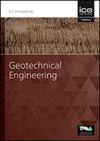Secondary reinforcement effect on the value and location of maximum reinforcement load
IF 1.7
4区 工程技术
Q3 ENGINEERING, GEOLOGICAL
Proceedings of the Institution of Civil Engineers-Geotechnical Engineering
Pub Date : 2023-11-08
DOI:10.1680/jgeen.23.00048
引用次数: 0
Abstract
This paper numerically evaluates the effect of secondary reinforcement on the value and location of the maximum reinforcement load along the primary reinforcement layers (T max ) in geosynthetic-reinforced soil (GRS) walls under working stress conditions. Data from three instrumented sections of a well-instrumented GRS wall were used for model validation. A parametric study was carried out considering different controlling factors (i.e. the vertical reinforcement spacing, facing type and secondary reinforcement stiffness and length). The results show that for a constant relative soil-reinforcement stiffness index, the variation of the vertical reinforcement spacing and stiffness may not affect the location and normalised value of T max . In general, for the conventionally used type of reinforcement, the secondary reinforcement inclusion reduces T max to values lower than those corresponding to the active condition (K a ). For a given facing type, the combined effect of the secondary reinforcement length and stiffness is the main factor that controls the T max location. In general, increasing the secondary reinforcement stiffness and length moves the location of T max from the back of the facing to a distance corresponding to the length of the secondary reinforcement layers. In addition, for this condition, a flexible face model performs similarly to a block face model.二次配筋对最大配筋荷载的取值和位置有影响
本文数值计算了在工作应力条件下,二次加筋对土工合成土(GRS)墙体沿主筋层最大加筋荷载(tmax)的取值和位置的影响。来自三个仪器测量的GRS壁的数据用于模型验证。考虑不同控制因素(竖向配筋间距、面板类型、二次配筋刚度和长度),进行了参数化研究。结果表明:当土-筋相对刚度指标一定时,竖向筋间距和刚度的变化不会影响T max的位置和归一化值;一般来说,对于常规使用的钢筋类型,二次钢筋夹杂物将tmax降低到低于活性条件(K a)对应的值。对于给定面板类型,二次配筋长度和刚度的综合作用是控制最大配筋位置的主要因素。一般来说,增加二次配筋刚度和长度会使T max的位置从面板背面移动到与二次配筋层长度相对应的距离。此外,对于这种情况,柔性面模型的执行类似于块面模型。
本文章由计算机程序翻译,如有差异,请以英文原文为准。
求助全文
约1分钟内获得全文
求助全文
来源期刊
CiteScore
4.40
自引率
4.50%
发文量
68
审稿时长
3 months
期刊介绍:
Geotechnical Engineering provides a forum for the publication of high quality, topical and relevant technical papers covering all aspects of geotechnical research, design, construction and performance. The journal aims to be of interest to those civil, structural or geotechnical engineering practitioners wishing to develop a greater understanding of the influence of geotechnics on the built environment.

 求助内容:
求助内容: 应助结果提醒方式:
应助结果提醒方式:


